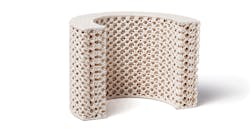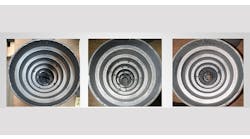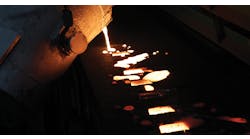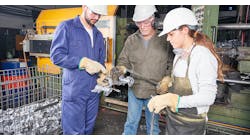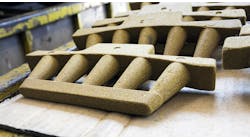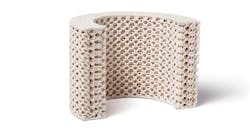Controlling Gas Defects in Chemically Bonded Sand Castings
Q: How can we address gas porosity in finished castings? Subsurface defects add production costs due to extra cleaning time for each affected part, and some scrapped castings have to be re-poured to meet customers’ orders.
A: Some foundries have been known to add machine stock to a part’s design in order to establish more material that may be ground or machined out of the casting, and make it salable. This practice, while effective for meeting orders, does not address the cause of the defect and meet the goal of producing defect-free castings.
Gas porosity is characterized by smooth round voids in the casting, typically subsurface and often on the cope surface. Possible sources of the defect are high binder levels, lack of mold permeability, and poor gating practices.
• Binder levels should be monitored closely to contain operating costs. How much binder a foundry uses can vary based on sand and binder type, and desired strength. The amount used at each foundry should be the lowest amount needed to achieve safe handling strength and deliver enough mold/core strength to prevent other defects such as penetration or warpage. Regular mixer calibrations will ensure the desired binder and sand flow levels.
If a foundry is reclaiming sand, residual binder contributes to Loss On Ignition (LOI) at the mold/metal interface. LOI values consistently above 2% (prior to adding new binder to the sand) may contribute to gas defects. New sand additions can be made to reduce LOI if a reclamation system is performing optimally. A side benefit to reducing reclaimed sand LOI is the potential to use lower-than-normal binder levels while maintaining tensile strength.
• To consider mold permeability, look at the physical properties of the sand itself and molding practices. Round-grain sands and the spherical nature of man-made ceramic media will have better mold permeability compared to similar AFS GFN sub-angular sands, like lake sands. Lower grain-fineness sands will have higher permeability than higher GFN sands. It’s not surprising that high fines (material on the 200 screen and below) will negatively affect mold permeability. Classification and dust-collection systems should keep fines below 1% during reclamation. A lower level of fines also will decrease binder demand.
Good venting practice will help mold permeability, too. Cores are vented to help prevent binder decomposition gases from being trapped in the casting. Mold venting comes in a few types: scratch vents, flow-off vents, and top-down or “prick” venting. Flow-off vents allow the air inside the mold cavity to be displaced as the mold fills with metal. However, these vents freeze off quickly which can make them inadequate for relieving binder decomposition gases.
Top-down vents are made from the strike-off surface of the cope or drag but stop within 1-2 inches of the casting face. As the binder decomposes, these “air gaps” will give a shorter and easier path for the gas to escape the mold. As long as mold-handling strength is not compromised, a mold cannot have too many top-down vents.
Scratch vents are used at the parting line to alleviate gas. With these vents, care should be taken to ensure metal does not escape the parting line causing a run out.
• Casting geometry and gating practices will affect gas defects in castings as well, particularly for castings with narrow geometries or with metals that are prone to skinning-over. Filling molds as quickly as possible to reduce the chances of premature cooling and solidification also will prevent subsurface gas defects.
Ensuring pouring temperatures are appropriate for the alloy being cast is important to prevent early solidification. Binder decomposition gases from a sand core, for example, will escape through liquid metal. If the metal skins over and the core is still creating gas, the risk of gas porosity increases. Size of ingates and the path of metal flow in a mold cavity may dictate all of the above. Casting simulation software will analyze temperature gradients during pouring and solidification as well as predict levels of solidification versus time in a casting.
If gas defects affect the productivity and profitability of your foundry, consider your binder levels, sand and mold permeability, and evaluate software tools for analyzing your gating system. Any or all of these will help to eliminate gas defects and ensure you make a casting right the first time.
Join the Conversation. Email Your Questions for ASK Chemicals
Share your insights, opinions, and elaborate on the questions and the experts' answer(s). You must be logged in to the website in order to post your comments.
